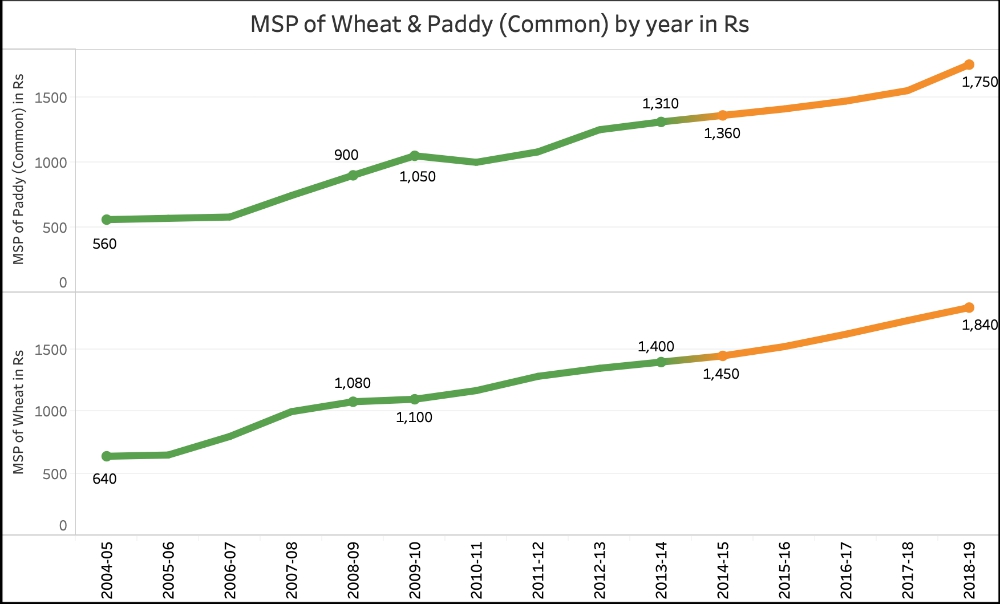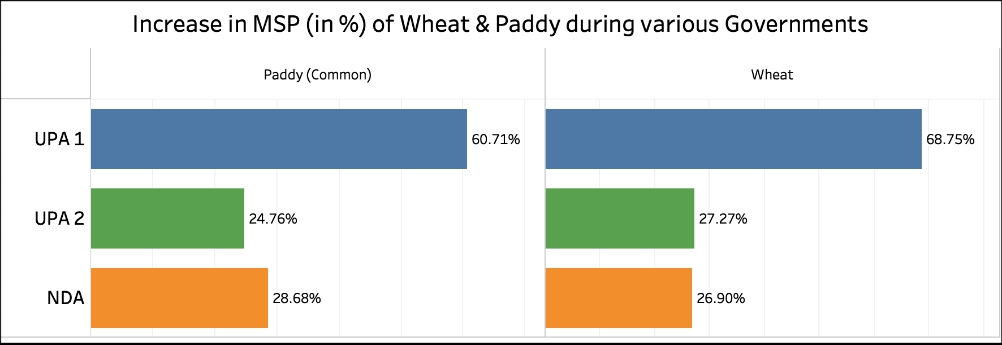[orc]A section on the Congress’s website talks about achievements during the UPA. One such claim relates to substantial increase in MSP during the UPA. Here is a fact check.
One of the claims made by the Indian National Congress on its website is regarding substantial increase in Minimum Support Price (MSP) of Wheat & Paddy during the UPA. Here is a fact check of this claim.
What is MSP?
The Commission for Agricultural Costs & Prices (CACP) since 1985, earlier named as Agricultural Prices Commission) came into existence in January 1965. The 2017-18 annual report of the Ministry of Agriculture and Farmers Welfare states that, ‘CACP was set up with a view to evolve a balanced and integrated price structure, and is mandated to advise on the price policy (MSP) of 23 crops. These include seven cereal crops (paddy, wheat, jowar, bajra, maize, ragi and barley), five pulse crops (gram, tur, moong, urad and lentil), seven oilseeds (groundnut, sunflower seed, soybean, rapeseed-mustard, safflower, nigerseed and sesamum), copra (dried coconut), cotton, raw jute and sugarcane.’
In order to understand the MSP better, it is important to know the determinants of it. The same annual report also states that, ‘Cost of production (CoP) is one of the important factors in the determination of MSP of mandated crops. Besides cost, the Commission considers other important factors such as demand and supply, price trends in the domestic and international markets, intercrop price parity and terms of trade between agricultural and non-agricultural sectors, the likely impact of MSPs on consumers, in addition to ensuring rational utilization of land, water and other production resources.’ Thus, pricing policy i.e. the exercise of MSP is not based on cost only though cost is an important determinant of MSP. To understand more about what MSP is and its constituents, watch Factly’s explainer video on MSP.
Has MSP increased substantially?
Another claim made on the Indian National Congress’ website is, ‘The Congress-led UPA believes that the nation can’t progress unless the farmer gets a fair price for his produce. The Minimum Support Price (MSP) for Wheat has been more than doubled, from Rs 640 per quintal in 2004-05 to Rs 1,285 in 2011-12. Similarly, the MSP for Paddy has been increased from Rs 560 in 2003-04 to Rs 1250 per quintal in 2011-12.’
The Directorate of Economics and Statistics & Reserve Bank of India’s handbook of statistics have data related to the MSP of various crops over the years. The Open Government Data (OGD) platform of the government also has the MSP for the years between 2003 and 2012.
It can be seen from the data that the MSP for wheat did increase from Rs. 640 per quintal in 2004-05 to Rs.1285 per quintal in 2011-12. By the end of UPA’s second term in 2013-14, the MSP for wheat was Rs. 1400 per quintal. During the current government, the MSP for wheat increased from Rs.1450 per quintal in 2014-15 to Rs. 1840 per quintal in 2018-19.
In the case of paddy, MSP in 2003-04 was Rs. 550 and it increased to Rs. 1080 in 2011-12 where as the numbers in the claim correspond to 2004-05 & 2012-13. The MSP for Paddy increased to Rs. 1310 per quintal by the end of UPA’s term. In the of the current government, the MSP for paddy increased from Rs. 1360 per quintal in 2014-15 to Rs. 1750 per quintal in 2018-19. It has to be noted that these prices correspond to Paddy (Common) and not grade ‘A’ paddy. If the percentage increase in MSP during various governments is considered, MSP for both paddy (common) & wheat increased by more than 60% during UPA’s first term. During UPA’s second term, the MSP for paddy increased by only 25% and by 27% in the case of wheat. The current NDA government increased the MSP for paddy by close to 29% and by 27% in the case of wheat.
If the percentage increase in MSP during various governments is considered, MSP for both paddy (common) & wheat increased by more than 60% during UPA’s first term. During UPA’s second term, the MSP for paddy increased by only 25% and by 27% in the case of wheat. The current NDA government increased the MSP for paddy by close to 29% and by 27% in the case of wheat.
Claim: The Minimum Support Price (MSP) for Wheat has been more than doubled, from Rs 640 per quintal in 2004-05 to Rs 1,285 in 2011-12. Similarly, the MSP for Paddy has been increased from Rs 560 in 2003-04 to Rs 1250 per quintal in 2011-12.
Fact: While these numbers are TRUE, it has to be noted that MSP increased by the greatest percentage during UPA 1. The current NDA government did better than UPA 2 in the case of MSP for paddy while it increased the MSP of wheat by more or less the same percent as UPA 2.
Featured Image: Rice Paddy Field by Mikko Koponen[Creative Commons 2.0]
This story is part of a larger series on the 4-years of the Modi government. This series has been made possible with the flash grant of the International Fact Checking Network (IFCN). Read the rest of the stories in this series here.


